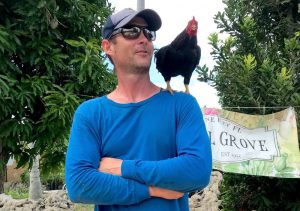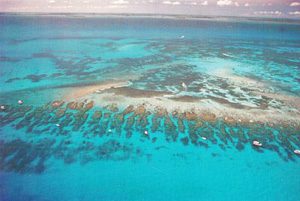With an environment filled with terrestrial and marine wildlife, Big Pine & the Lower Keys is the least “people-populated” area of the Florida Keys. In fact, the majority of its inhabitants have fur, fins or feathers.
Stretching from the west end of the Seven Mile Bridge at Little Duck Key (mile marker 40) to Stock Island at mile marker 5, the Lower Keys are home to two national wildlife refuges, part of a national marine sanctuary and a state park.

The beach area at Bahia Honda State Park, repeatedly rated among the best in the US, is one of the Florida Keys’ most serenity-inducing spots. (Photo by Rob O’Neal, Florida Keys News Bureau)
The region’s focus on the environment has earned it the title of the Natural Keys, and no visit would be complete without encountering some of its native wildlife.
What are some “don’t miss” stops when you’re visiting the Lower Keys?
Bahia Honda State Park. Home to a world-renowned beach, Bahia Honda State Park (located oceanside at mile marker 36.5), offers the perfect getaway for everyone in the family. Along with its historic bridge and pristine waters, the park features picnic and camping facilities, rental cabins, kayaking, daily snorkeling tours to Looe Key Reef, a marina, nature trails and a nature center.
Grimal Grove. The historic tropical fruit grove near Big Pine Key’s mile marker 30.5 was first owned by inventor and recluse Adolf Grimal, who amassed hundreds of rare fruit trees and created raised garden beds and waterways for irrigation. After his 1997 death, the property fell into a shambles. In 2013 Patrick Garvey and Growing Hope Initiative restored it as a tropical fruit park. Today, under Garvey’s stewardship, it’s the continental United States’ only breadfruit grove. Tours are available by appointment, and the property also hosts activities including youth education and yoga.
National Key Deer Refuge. In 1957 the refuge was established to protect and preserve habitats for wildlife — particularly the tiny, shy Key deer that are about the size of a large dog. The refuge’s 9,000-plus acres include mangrove forests, freshwater and salt marsh wetlands, pine rockland forests and tropical hardwood hammocks. While the Florida Keys National Wildlife Refuges Nature Center, near mile marker 30.5, remains temporarily closed because of coronavirus concerns, the graceful deer can often be seen grazing around Big Pine.

Patrick Garvey is the owner and operator of Big Pine Key’s Grimal Grove, a unique breadfruit grove, and is passionate about supporting the environment by growing fruits and other food sustainably.
Blue Hole. Find this secluded oasis off Big Pine’s Key Deer Boulevard, just 3 miles north of its intersection with the Florida Keys Overseas Highway. An abandoned quarry, the Blue Hole exposes the Keys’ unique freshwater lens and attracts a wide array of wildlife. Key deer drink there, while other occupants include alligators, turtles, snakes, fish and a variety of birds. Enjoy the view from the observation platform or venture along the forested edges of the walking trail.
Big Pine Kayak Adventures. Author/photographer Captain Bill Keogh and his crew have operated Big Pine Kayak Adventures since 1992. Located off the Overseas Highway at mile marker 30, the business offers paddling tours and boating eco-tours. The fleet used for rentals and tours includes beginner kayaks, sea kayaks, fishing kayaks, paddleboards and canoes. A Carolina 24 motor skiff can be used to transport kayaks and adventurers to remote wildlife refuge and backcountry spots.
Looe Key Reef. This unique preserve is named for HMS Looe, a British frigate that ran aground in 1744. The waters surrounding the reef provide spectacular views of sponges, soft corals, vibrant elkhorn and staghorn coral thickets and a variety of fish. Looe Key Reef Resort & Dive Center at mile marker 27.5 and other Lower Keys commercial charters provide excursions to Looe Key. The reef is the site of the annual Underwater Music Festival.

The unique Underwater Music Festival takes place at Looe Key Reef, an area of the Florida Keys National Marine Sanctuary about 6 miles south of Big Pine Key.
Skydive Key West. Visitors can enjoy the “bucket list” adventure of skydiving above blue water and island landscapes at Skydive Key West, located on Sugarloaf Key’s Bat Tower Road at mile marker 17. Certified tandem instructors employ rectangular, aerodynamic parachutes for easy maneuverability and “tiptoe soft” landings. After a nearly 20-minute climb to an altitude of 10,000 feet, jumpers leave the plane and descend at a speed of 120 mph from nearly 2 miles above the Keys.
Geiger Key Marina. At this Lower Keys hideaway spot — a favorite of locals — visitors will find a laid-back “fish camp” atmosphere and an eatery that serves deftly prepared casual fare. Located at mile marker 10, the restaurant at Geiger Key offers super-fresh local seafood, delicious in-house specialties and relaxing open-water views. Other attractions include an RV park, fishing charters, paddleboards and kayaks for exploring the nearby waters.
Sheriff’s Animal Farm. The Sheriff’s Animal Farm, located near mile marker 5 on Stock Island, is an attraction for all ages featuring horses, ponies, peacocks, pigs, African spurred tortoises and exotic animals like Mo the sloth, Kelsie the lemur, two alpacas and an albino python. The farm is temporarily closed to the public because of the coronavirus, but normally it’s open 1-3 p.m. on the second and fourth Sunday of each month. Admission is free.
Want to know more about unique attractions in the Lower Keys? Just click here.

